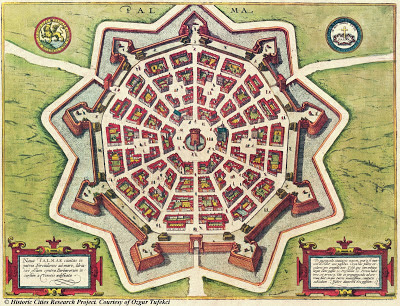Todeskino completed the
film Architectura caelestis.
Being the first of a new series called New Film Conceptions, the material for the film was shot in the city of Palmanova in northern Italy, one of the few original european ideal planned cities, built in the late 16th century.
Being the first of a new series called New Film Conceptions, the material for the film was shot in the city of Palmanova in northern Italy, one of the few original european ideal planned cities, built in the late 16th century.
From a central point on
the hexagonal main square there are different zoom shots of the 6 star shaped main roads.
6 pannings of 60 degrees are linking the zoom shots in two turnarounds.
The duration of each zoom
shot through one position/road as well as the length and therefore velocity of
the pannings are composed after the Fibonacci
numbers and the golden section.
After our work Ars combinatoria, in
this new cycle New Film Conceptions, we
carry on composing film frame by frame after these architectural principles,
expanding certain structural or metric ideas in the history of avantgarde film.
This way of editing mirrors
the space itself like in our film Le
dernier art, in the case of Palmanova depicting, structurally and
metrically, a Fibonacci spiral that
is a symbol for a kind of golden proportional celestial or divine architecture
reflecting archetypic forms in the human psyche as well.
The zoom shots follow
different series of 2-3-5-8-13-21 frames, the pannings increase velocity in steps
of 377-233-144-89-55-34 frames, almost geometrically measuring space-time filmically,
transcribing it on to the frame numbers of the film strip, an approach that is
perhaps quite unique in avantgarde cinema. Moreover the zoom shots put together
various jump cut scenes relativating events in the time line, the film is even optical printed backwards and extended to 4 turnarounds, like
C.G. Jung explains, in the unconscious everything is taking place simultaneously,
life and death, like waltzing clockwise and counterclockwise. And his colleague
Karl Kerenyi says, we escape the archetypic reeling in the labyrinth of death
and unconsciousness via an aspiration towards the celestial realm (another
metaference to the film reel). All that visionary film can be, and that pure digital cinema
that is not based on framework and analogue material can not be to the same
extend: frenzy, a sometimes enraptured ecstatic experience leaving us in a
whirling, lurching dizziness.
Or to quote the hermetic, alchemic "Emerald Tablet": "That which is below is like that which is above that which is above is like that which is below to do the miracles of one only thing."
Or to quote the hermetic, alchemic "Emerald Tablet": "That which is below is like that which is above that which is above is like that which is below to do the miracles of one only thing."
Palmanova could be seen as
a huge mandala to live in (see bird’s eye view). But for us these symbols are
rather means of transgression than
neo-religious attemps to reconcile the human psyche with its true „self“ and
collective, transindividual wholeness, a neverending approach according to C.G.
Jung. With transgression we mean a certain possibility of (inner) mythical
experience that is breaking with the cultural forms, but unlike Georges
Bataille, who claims that culture is sustained and completed by what transgresses
it, we want to emphasize on the part of breaking in the original meaning of the
symbol, not on the communication or its suspension (like for instance in
deconstruction).
 |
| still from "Architectura caelestis" by Todeskino |
 |
| the city of Palmanova, Italy from bird's eye view |
 |
| Palmanova, the hexagonal "piazza grande" |
 |
| old city maps of Palmanova |
 |
| stained glass window of the cathedral of Chartres |
 |
| the mandala like cross section through the human DNA the Fibonacci sequence in the human skeleton: |
 |
| "Modulor" by Le Corbusier, attempt to base modern architecture on objective measures according to the golden ratio and the human body |
 |
| man in the pentagram that draws the golden section, Agrippa von Nettesheim, De occulta philosophia, early 16th century |
 |
| the Fibonacci spiral in nature, the Nautilus |
 |
| the Fibonacci spiral and golden section in art, Leonardo da Vinci's "Mona Lisa" and Michelangelo's "The Creation of Adam" William Blake, "Newton" |









